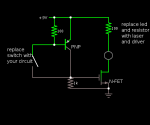Zom-B
0
- Joined
- Mar 25, 2008
- Messages
- 895
- Points
- 28
To increase the voltage of the regulator, stick some power diodes in leg 2 to increase it with steps ov 0.7V.
Try injecting a voltage at IC pin 3 of the opamp (or disconnect the opto and put a 9V battery instead of the 4.7K) and see if it works then.
Measure the voltage at pin 2 and 6. When 2 is lower then 3, 6 should be Vdd, when 2 is higher than 3, 6 should be 0V.
That's all I can give you remotely.
Try injecting a voltage at IC pin 3 of the opamp (or disconnect the opto and put a 9V battery instead of the 4.7K) and see if it works then.
Measure the voltage at pin 2 and 6. When 2 is lower then 3, 6 should be Vdd, when 2 is higher than 3, 6 should be 0V.
That's all I can give you remotely.







